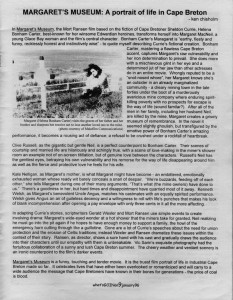 In Margaret’s Museum, the Mort Ransen film based on the fiction of Cape Bretoner Sheldon Currie, Helena Bonham Carter, best-known for her winsome Edwardian heroines, transforms herself into Margaret MacNeil, a young Glace Bay woman and the film’s central character. Bonham Carter’s Margaret is “earthy, feisty and funny, recklessly honest and instinctively wise” – to quote myself describing Currie’s fictional creation. Bonham Carter, mastering a flawless Cape Breton accent, captures Margaret’s raw vulnerability and her iron determination to prevail. She does more with a mischievous glint in her eye than other actresses do in an entire movie. Wrongly reputed to be a “snot-nosed whore”, her Margaret knows she’s an outsider in an already marginalized community—a dreary mining town in the late ‘40s under the boot of a murderously avaricious mine company where enduring spirit-killing poverty with no prospects for escape is the way of life (sound familiar?). After all of the men in her family are killed by the mine, Margaret creates a grisly museum of remembrance. In the novel it seemed slightly ghoulish, but transformed by the emotive power of Bonham Carter’s amazing performance, it becomes a rousing act of defiance; a refusal to be crushed under a rockfall of heartbreak.
In Margaret’s Museum, the Mort Ransen film based on the fiction of Cape Bretoner Sheldon Currie, Helena Bonham Carter, best-known for her winsome Edwardian heroines, transforms herself into Margaret MacNeil, a young Glace Bay woman and the film’s central character. Bonham Carter’s Margaret is “earthy, feisty and funny, recklessly honest and instinctively wise” – to quote myself describing Currie’s fictional creation. Bonham Carter, mastering a flawless Cape Breton accent, captures Margaret’s raw vulnerability and her iron determination to prevail. She does more with a mischievous glint in her eye than other actresses do in an entire movie. Wrongly reputed to be a “snot-nosed whore”, her Margaret knows she’s an outsider in an already marginalized community—a dreary mining town in the late ‘40s under the boot of a murderously avaricious mine company where enduring spirit-killing poverty with no prospects for escape is the way of life (sound familiar?). After all of the men in her family are killed by the mine, Margaret creates a grisly museum of remembrance. In the novel it seemed slightly ghoulish, but transformed by the emotive power of Bonham Carter’s amazing performance, it becomes a rousing act of defiance; a refusal to be crushed under a rockfall of heartbreak.
Clive Russell, as the gigantic but gentle Neil, is a perfect counterpoint to Bonham Carter. Their scenes of courtship and married life are hilariously and achingly true, with a scene of love-making in the miners’ shower room an example not of on-screen titillation, but of genuine love between the characters. Russell’s Neil has the gentlest eyes, betraying his own vulnerability and his remorse for the way of life disappearing around him as well as the fierce and protective love he feels for his wife.
Kate Nelligan, as Margaret’s mother, is what Margaret might have become—an embittered, emotionally exhausted woman whose ready wit barely conceals a snarl of despair. “We’re buzzards, feeding off of each other,” she tells Margaret during one of their many arguments. “That’s what the mine owners have done to us.” There’s a goodness in her, but hard times and disappointment have quarried most of it away. Kenneth Welsh, as Margaret’s benevolent Uncle Angus, matches his castmates with an equally spirited performance. Welsh gives Angus an air of guileless decency and a willingness to roll with life’s punches that makes his look of blank incomprehension after opening a pay envelope with only three cents in it all the more affecting.
In adapting Currie’s stories, scriptwriters Gerald Wexler and Mort Ransen use simple events to create involving drama: Margaret’s wide-eyed wonder at a hot shower that the miners take for granted, Neil realizing he must go into the pit again if he hopes to have enough money to support his family, the howl of the emergency horn cutting through like a guillotine. Gone are a lot of Currie’s speeches about the need for union protection and the erosion of Celtic traditions; instead, Wexler and Ransen dramatize these issues within the context of their story. Ransen, as director, shows a sure hand with his cast and gradually draws the audience into their characters until our empathy with them is unbreakable. Vic Sarin’s exquisite photography had the fortuitous collaboration of a sunny and lush Cape Breton summer. The cheery weather and verdant scenery is an ironic counterpoint to the film’s darker events.
Margaret’s Museum is a funny, touching and tender movie. It is the truest film portrait of life in Industrial Cape Breton so far. It celebrates lives that have either been overlooked or romanticized and will carry to a wide audience the message that Cape Bretoners have known in their bones for generations—the price of coal is blood.

